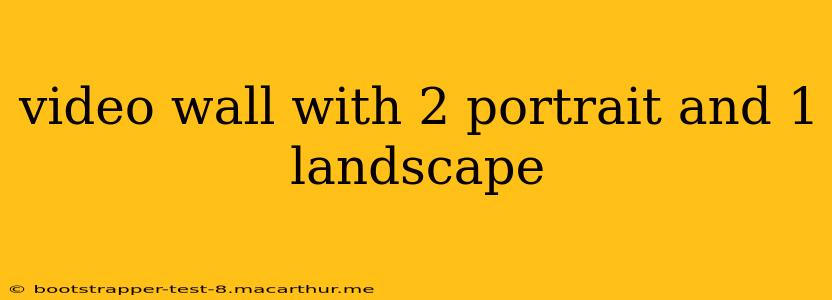Creating a compelling video wall often involves careful consideration of display orientation and arrangement. This guide explores the unique challenges and opportunities presented by a video wall configuration featuring two portrait-oriented screens and one landscape-oriented screen. We'll delve into the technical aspects, design considerations, and practical applications of such a setup.
What are the Advantages of a 2 Portrait, 1 Landscape Video Wall?
This unconventional arrangement offers several distinct advantages:
-
Visual Variety: The mix of portrait and landscape orientations creates a dynamic and visually engaging display, breaking away from the monotony of a uniform grid. This is particularly effective for showcasing diverse content types, such as social media feeds, live video streams, and static images.
-
Content Flexibility: The varied orientations allow for versatile content presentation. You could use the portrait displays for vertical scrolling content like news tickers or social media feeds, while the landscape screen displays wider content like video presentations or dashboards.
-
Space Optimization: Depending on the available space, this configuration can be more efficient than a solely landscape-oriented setup, allowing you to present more information within a confined area.
How to Design a Video Wall with 2 Portrait and 1 Landscape Screens?
Successfully implementing this type of video wall requires meticulous planning:
1. Choosing the Right Displays:
The first step is selecting displays with appropriate resolutions and aspect ratios. Ensure that your chosen screens are compatible with the video processing system and can seamlessly integrate to create a unified image. Consider factors like brightness, contrast, and color accuracy to maintain visual consistency across all screens.
2. Selecting the Video Processor:
A powerful video processor is crucial for managing the different resolutions and orientations. It needs to seamlessly stitch the images together, ensuring smooth transitions and minimal latency. Research processors specifically designed for multi-display setups with varying aspect ratios.
3. Content Creation and Management:
Creating content for a video wall with mixed orientations requires careful planning. You'll need to design assets that are optimized for each screen's aspect ratio, ensuring they fit seamlessly and create a cohesive overall visual experience. Consider using video wall management software to simplify content scheduling and distribution.
4. Physical Installation and Cabling:
Professional installation is recommended to ensure proper alignment and seamless integration. Careful cable management is essential to avoid clutter and ensure reliable signal transmission.
What Software is Suitable for this type of Video Wall?
Many video wall control software packages offer the flexibility to manage displays with different orientations. Look for software that supports bezel correction (to minimize the visible gaps between screens), allows for flexible content zoning, and offers features like scheduling and remote management. The specific software choice depends on your budget, technical expertise, and specific content requirements.
What are the Common Challenges?
-
Content Creation: Creating visually cohesive content across different aspect ratios can be challenging. Requires careful planning and design to ensure everything aligns perfectly.
-
Cost: A video wall system, especially one with high-resolution displays and a sophisticated video processor, can be a significant investment.
-
Maintenance: Regular maintenance is crucial to ensure the longevity and optimal performance of the system. This includes cleaning the screens, checking the connections, and updating the software.
What are the Applications for this type of Video Wall?
This unique video wall configuration finds applications in various settings:
-
Digital Signage: Showcase a mix of dynamic information, such as real-time stock tickers, social media feeds, and promotional videos.
-
Control Rooms: Display critical data from various sources, utilizing the portrait screens for detailed information and landscape screens for overviews.
-
Museums and Galleries: Present a blend of high-resolution images and interactive displays.
-
Retail Environments: Combine product showcases with engaging promotional content and real-time sales data.
By carefully considering the factors outlined above, you can design and implement a captivating and functional video wall with two portrait and one landscape display that enhances your space and effectively communicates your message. Remember that professional consultation can significantly aid in navigating the technical complexities of such a project.
